Anyone expecting the ASUS GTX 950-2G “unplugged” to perform the same as standard GTX 950 may be disappointed by the results we have recorded – in general it falls behind by a margin of 20% or so. However, the GTX 950-2G is best thought of as an alternative to the GTX 750 Ti, rather than simply another GTX 950.
At $155 in North America and £130 here in the UK the ASUS GTX 950 unplugged costs the same as many other entry-level GTX 950s but its real competition is the GTX 750 Ti which starts at around $110/£90. As such the GTX 950-2G ends up being about 30% more expensive and returns slightly less relative performance, anything between 10 to 25% depending on the game in question and the system resolution.

The GTX 950-2G will certainly not be top of everyone's shopping list but if prospective buyers were already considering a GTX 750 Ti, then the GTX 950-2G is a higher performance alternative that will make 1080p gaming that extra bit smoother and more enjoyable.
Due to the absence of additional power connectors it's just as easy as it was with the GTX 750 Ti to drop the GTX 950-2G into any PCI Express equipped system and get a reasonable 1080p gaming experience.
Naturally, there will be other factors to consider including the fact that performance will vary depending on the CPU, system memory configuration and whether the power supply is up to the job. Even though the GTX 950-2G is frugal on power, a power supply already close to capacity – particularly if it is a low-quality unit, may still encounter issues by the up to 75-watts of power draw through the PCIe bus on the motherboard.
Since most pre-built OEM systems from the likes of Acer, Dell and others often have plenty of spare power supply capacity most consumers are unlikely to encounter any issues and may even be able to benefit from overclocking gains too. While the GTX 950-2G is slightly larger than most GTX 750 Ti's it is still compact enough to sit comfortably on any mini-ITX, micro-ATX or full-ATX motherboards, posing no notable compatibility issues.
Despite ASUS being the most vocal about its GTX 950 without the 6 pin, similar models are offered by rival brands including EVGA, who are selling 4 different models, and MSI. Pricing is broadly similar between these brands though it does vary by region and retailer.
Buy from Amazon UK for £136.56 HERE.
Pros:
- Performance upgrade over GTX 750 Ti.
- Light on power consumption.
- Excellent acoustic and thermal performance.
- Hassle-free upgrade path.
Cons:
- Relative price premium over GTX 750 Ti doesn't match the relative performance increase.
KitGuru says: The ASUS GTX 950-2G “unplugged” offers a notable performance boost over the GTX 750 Ti for an impressive low-power 1080p gaming experience.

 KitGuru KitGuru.net – Tech News | Hardware News | Hardware Reviews | IOS | Mobile | Gaming | Graphics Cards
KitGuru KitGuru.net – Tech News | Hardware News | Hardware Reviews | IOS | Mobile | Gaming | Graphics Cards



Curious timing for this review with the low power RX cards due soon. It would be good to see a follow up review comparing this to those.
Unfortunately people buying this card will be building on a budget and won’t be running watercooled intel i7’s on an SSD with 32gb of high speed DDR4 ram, meaning the results will be VERY different for them.
I know it has been reviewed this way to show the cards true potential without any bottlenecking, but if anybody sees these results, then buys the gpu to pair with their £60 stock cooled amd processor and 4gb of RAM, running on a 7200rpm HDD disk then they are going to be devastated when they get massively worse results.
Personally, i’d rather see GPU’s tested in the average setup they will be expected to be bought for.
Thanks for the feedback, it is a tricky situation – keeping a test bench consistent between a wide range of products (as low as R7 360 but as high as R9 390) but also needing to make sure it matches the target audience for a given product, such as in this case. Having test benches that reflect different price points (low-mid range, mid to high-end) is something I’ll (re)consider going forward as I have done this before in my reviewing career.
Definitely, we’ll try and take a look at as many new products as possible including anything new from AMD in the same power/performance segment.
Definitely something i’d look forward to seeing. I would also find it very interesting to see how much of a bottleneck a budget setup vs a test rig like this would be, but that also doubles the amount of work required for a review.
Either way, it is a very good review, and I like seeing the lower end products getting highlighted.
Thanks for the response Ryan.
I am earning around 6000-8000 dollars a month for freelancing i do from my home. For everybody prepared to do simple online jobs for few hours a day from your couch at home and make solid payment while doing it… Try this work SELF90.COM
I’m running an Elsa GTX 950 2GB (Great Japanese brand, no power connector) on a 10 year old Asus P5 Mobo Win 10 X64 Pro with a Q9650 and 8gb cheapo ram (Nanya PC2-6400 DDR2-SDRAM) and it runs Doom 2016 Vulkan on medium at ~45fps. No Mans Sky, XCOM 2 also perform really well on medium settings. Bear in mind it’s running in a PCI Express 1.1 slot too.
I had an Asus GTX 750Ti in there but it started going crazy with the fan going on and off, and I found this Elsa 950 in Akihabara going really cheap. Knocks the 750Ti out of the park.
I think it’s this one: http://www.elsa-jp.co.jp/products/products-top/graphicsboard/geforce/midrange/geforce_gtx950_2gb/